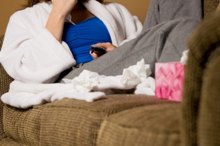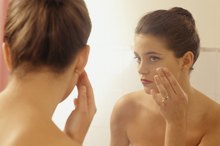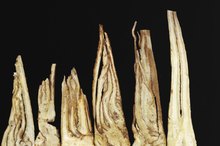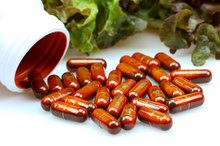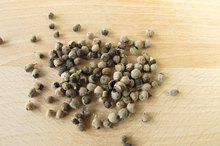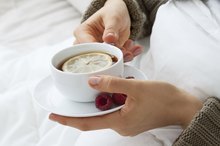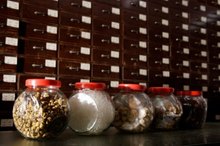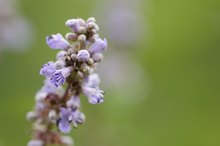Are There Supplements That Reduce Testosterone in Women with PCOS?
Polycystic ovary syndrome, or PCOS, is the most common metabolic hormonal disorder affecting women of reproductive age. The exact cause is unknown, but there appears to be a genetic component. One of the hallmarks of PCOS is dysfunction of the ovaries, which result in lower levels of estrogen and higher levels of testosterone, an androgen hormone. Symptoms of excessive testosterone include hirsutism, or excess dark facial and body hair; infrequent menstruation, hair loss and possibly a deep voice. Discuss treatment options with your doctor because there are some supplements that may help reduce testosterone levels.
Saw Palmetto
Saw palmetto is a type of small palm tree that is native to parts of the southern United States. The tree produces a berry that is used in making herbal medicines. Saw palmetto is traditionally thought of as a men's herb because of its frequent use in treating an enlarged prostate. However, because the herb has anti-androgenic properties that act to lower testosterone levels, it has also found some use in the treatment of PCOS. "Prescription for Herbal Healing" by Phyllis A. Balch states that saw palmetto can improve hirsutism by blocking the effects of testosterone on hair follicles 2.
- Saw palmetto is a type of small palm tree that is native to parts of the southern United States.
- Saw palmetto is traditionally thought of as a men's herb because of its frequent use in treating an enlarged prostate.
Peony and Licorice
Herbs to Decrease Testosterone
Learn More
Three different varieties of peony are used in making herbal preparations: red peony, white peony and moutan. In all cases, the root and bark of the root is harvested to be used medicinally. Peony possesses some weak estrogen-like effects, which can be beneficial in treating PCOS.
The woody roots of licorice are collected after this perennial plant reaches three years old to be used in herbal supplements. According to the University of Michigan Health System, this herb also has some anti-androgenic activity and is often used in tandem with peony in the supplement known as shakuyaku-kanzo-to to lower the elevated testosterone levels seen in PCOS 3.
- Three different varieties of peony are used in making herbal preparations: red peony, white peony and moutan.
- The woody roots of licorice are collected after this perennial plant reaches three years old to be used in herbal supplements.
Spearmint
Spearmint, or Mentha spicata, is native to the Mediterranean region and a member of the mint family of plants 4. Its leaves are collected and dried for use in making herbal teas, tinctures and essential oils. A tea made from spearmint leaves appears to be able to lower testosterone levels in women and reduces the symptoms of hirsutism 4. Drinking one cup of spearmint tea twice daily, according to the University of Maryland Medical Center, may help reduce the amount of testosterone in the blood of women with PCOS 14.
Vitamin D and Calcium
Herbal Testosterone Blocker
Learn More
Getting the proper nutrition is also an important component in the treatment of PCOS. It's essential to maintain adequate levels of a number of vitamins and minerals, including the B vitamins, vitamin D, vitamin E, chromium, magnesium, calcium and zinc. Vitamin D is required for proper calcium absorption and calcium is needed for normal development of follicles each month; the effects of calcium are reduced when testosterone levels are elevated. A report published in the medical journal "Steroids" states that administration of vitamin D and calcium to women suffering from PCOS helped normalize their menstrual cycles within two months.
- Getting the proper nutrition is also an important component in the treatment of PCOS.
- A report published in the medical journal "Steroids" states that administration of vitamin D and calcium to women suffering from PCOS helped normalize their menstrual cycles within two months.
Related Articles
References
- University of Maryland Medical Center: Hirsutism; Steven D. Ehrlich, N.M.D.; September 2010
- "Prescription for Herbal Healing"; Phyllis A. Balch, C.N.C.; 2002
- University of Michigan Health Center: Peony; December 2009
- PubMed: "Steroids"; Vitamin D and Calcium Dysregulation in the Polycystic Ovarian Syndrome"; S. Thys-Jacobs et al.; June 1999
- Eunice Kennedy Shriver National Institute of Child Health and Human Development. What are the symptoms of PCOS?. Updated January 31, 2017.
- Garg A, Neuren E, Strunk A. Hidradenitis Suppurativa Is Associated with Polycystic Ovary Syndrome: A Population-Based Analysis in the United States. J Invest Dermatol. 2018;138(6):1288-1292. doi:10.1016/j.jid.2018.01.009
- Kalgaonkar S, Almario RU, Gurusinghe D, et al. Differential effects of walnuts vs almonds on improving metabolic and endocrine parameters in PCOS. Eur J Clin Nutr. 2011;65(3):386-393. doi:10.1038/ejcn.2010.266
- Adjarzadeh A, Dehghani Firouzabadi R, Vaziri N, Daneshbodi H, Lotfi MH, Mozaffari-Khosravi H. The effect of omega-3 supplementation on androgen profile and menstrual status in women with polycystic ovary syndrome: A randomized clinical trial. Iran J Reprod Med. 2013 Aug;11(8):665-72.
- Grant P. Spearmint herbal tea has significant anti-androgen effects in polycystic ovarian syndrome. A randomized controlled trial. Phytother Res. 2010 Feb;24(2):186-8. doi:10.1002/ptr.2900
- Haj-Husein I, Tukan S, Alkazaleh F. The effect of marjoram (Origanum majorana) tea on the hormonal profile of women with polycystic ovary syndrome: a randomized controlled pilot study. J Hum Nutr Diet. 2015. doi:10.1111/jhn.12290
- Fujita R, Liu J, Shimizu K, Konishi F, Noda K, Kumamoto S, et al. Anti-androgenic activities of Ganoderma lucidum. J Ethnopharmacol. 2005;102(1):107–12. doi:10.1016/j.jep.2005.05.041
- Nowak DA, Snyder DC, Brown AJ, Demark-Wahnefried W. The Effect of Flaxseed Supplementation on Hormonal Levels Associated with Polycystic Ovarian Syndrome: A Case Study. Curr Top Nutraceutical Res. 2007;5(4):177-181.
Writer Bio
Kathryn Meininger began writing and publishing poetry in 1967. She was co-founder and editor of the professional magazine "Footsteps" and began writing articles online in 2010. She earned a Doctor of Podiatric Medicine from Temple University School of Podiatric Medicine and a Bachelor of Arts in biology from William Paterson University.

